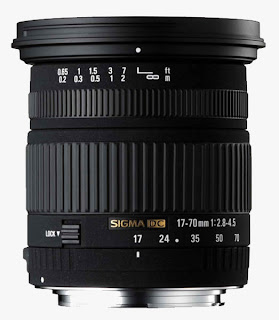
Ok let's get to the lens itself. Sigma 17-70mm f2.8-4.5 DC MACRO is in a pretty busy segment. It has a lot of competition, because it's the type of lens that everybody needs on an APS-C camera. That's why it was also highly anticipated, after it was announced. It's a DC (Digital Camera) lens specifically designed for the reduced image circle of today's APS-C DSLRs where its field of view is equivalent to 27-112mm on classic full frame SLRs. The lens is available in Canon EOS, Nikon and native Sigma mount. I tested it on Canon EOS 400D. The optical construction is made of 15 elements in 12 groups with 2 aspherical and one SLD (Special Low Dispersion) element. The aperture mechanism features 7 aperture blades. The minimal focus distance of 20 cm resulting in a maximum magnification of 1:2.3. The Sigma has no floating elements for close focus correction so don't expect wonders at extreme close focus settings. The lens extends significantly during zooming reaching its maximum length at 70mm. It measures 82.5 in lenght and 79 in diameter. It weights 455 g. Built quality is good, not like EX class, but better then most (or even all)of kit lenses. It features a standard micro AF motor, which is not that slower than HSM AF motor (it's surprisingly fast, at least at the center AF point), but it is noisier (but not to the extend to be annoying). Focus accuracy is good too. The front element does not rotate so using a polarizer remains easily possible. Filter size is 72 mm. A petal shaped hood is part of the package.
Sharpness is very good in the 17-50 mm range, when stopped down (1 stop or more) , average at 70 mm (even stopped down, it doesn't get much batter). The distortions are average, it suffers from barrel distortion at 17mm, it's quite pronounced. Vignetting is visible also at 17 mm at f2.8. Stopping down 1-2 stops helps to reduce vignetting down to a normal degree (making it hard to spot). I could say the same about CA.
Let's get to the test shots. Unfortunatelly all the photos were taken at ISO 400 (except for CA test), the light condiotions were really bad (I mentioned it before). I've added two crops under each photo. All the shots were taken at 70 mm. As you can see, sharpness is below average. I accidently erased shots taken at 17/24/35/50 mm, they were all better regarding sharpness. Please take this into account because this lens is pretty sharp in 17-50 mm range if stopped down for 1 stop and very sharp if stopped down 2-3 stops.

F4.5, 1/400, ISO 400



F5.6, 1/250, ISO 400



F8, 1/125, ISO 400


All the images below were taken at 17 mm at f2.8-f8(the first sample at f4) from top (f2.8) to the bottom (f8) . Crops show sharpness at various aperture settings, CA is visible on the first crop, on the others you can barely spot it or you even can't spot it.





In this standard CA test Sigma 17-70 performed excellent. I've posted a sample on which CA is most visible, on the other shots I didn't spot it.

F3.2, 1/640, 23 mm, ISO 100

Macro sample (there's a watermark with a www.slo-foto.net sign, don't be alert, I'm the author of the photo as well as author of the text - here's link to the review in slovenian http://www.slo-foto.net/reviews-120-page3.html )

F5, 1/80, 40 mm, ISO 400

Pros:
-sharpness when stopped down a bit (1 stop or more)
-almost no CA
-price
-built quality (at that price)
-fast AF (for a non HSM lens)
-large aperture (at least at the wide end)
-min. focus distance
Cons:
-sharpness wide open
-vignetting wide open
-sharpness at 70 mm at any aperture
